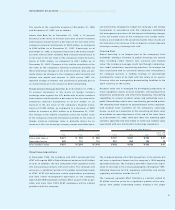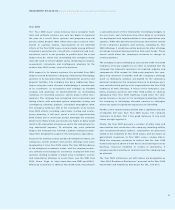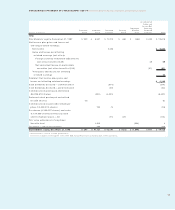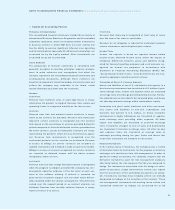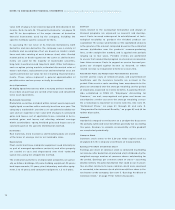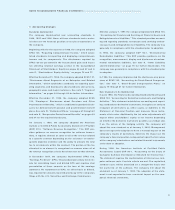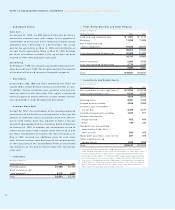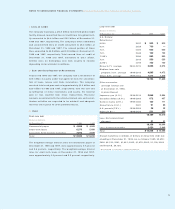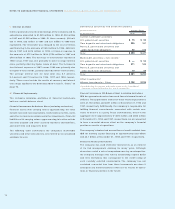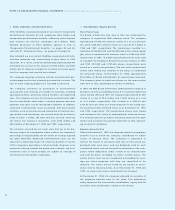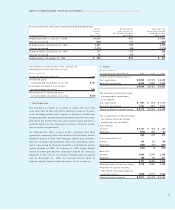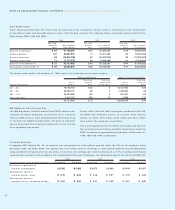IBM 1998 Annual Report Download - page 73
Download and view the complete annual report
Please find page 73 of the 1998 IBM annual report below. You can navigate through the pages in the report by either clicking on the pages listed below, or by using the keyword search tool below to find specific information within the annual report.
NOTES TO CONSOLIDATED FINANCIAL STATEMENTS International Business Machines Corporation and Subsidiary Companies
71
BAccounting Changes
Standards Implemented
The company implemented new accounting standards in
1998, 1997 and 1996. None of these standards had a mater-
ial effect on the financial position or results of operations of
the company.
Beginning with the first quarter of 1998, the company adopted
SFAS 130, “Reporting Comprehensive Income,” which estab-
lished standards for reporting and displaying comprehensive
income and its components. The disclosures required by
SFAS 130 are presented in the Accumulated gains and losses
not affecting retained earnings section in the Consolidated
Statement of Stockholders’ Equity on pages 66 and 67 and in
note O, “Stockholders’ Equity Activity,” on pages 76 and 77.
Effective December 31, 1998, the company adopted SFAS 131,
“Disclosures About Segments of an Enterprise and Related
Information,” which establishes standards for reporting oper-
ating segments and disclosures about products and services,
geographic areas and major customers. See note Y, “Segment
Information,” on pages 84 through 89 for further information.
Effective December 31, 1998, the company adopted SFAS
132, “Employers’ Disclosures about Pensions and Other
Postretirement Benefits,” which established expanded disclo-
sures for defined benefit pension and postretirement benefit
plans. See note W, “Retirement Plans,” on pages 81 through 83
and note X, “Nonpension Postretirement Benefits” on pages 83
and 84 for the required disclosures.
On January 1, 1998, the company adopted the American
Institute of Certified Public Accountants Statement of Position
(SOP) 97-2, “Software Revenue Recognition.” This SOP pro-
vides guidance on revenue recognition for software transac-
tions. It requires deferral of some or all of the revenue related
to a specific contract depending on the existence of vendor-
specific objective evidence and the ability to allocate the total
fee to all elements within the contract. The portion of the fee
allocated to an element is recognized as revenue when all of
the revenue recognition criteria have been met for that element.
In December 1997, the company implemented SFAS 128,
“Earnings Per Share” (EPS). This standard prescribes the meth-
ods for calculating basic and diluted EPS and requires dual
presentation of these amounts on the face of the earnings
statement. No restatement of EPS, for either basic or diluted,
was required for amounts reported previously in the company’s
filings with the U.S. Securities and Exchange Commission.
Effective January 1, 1997, the company implemented SFAS 125,
“Accounting for Transfers and Servicing of Financial Assets and
Extinguishments of Liabilities.” This standard provides account-
ing and reporting standards for transfers and servicing of finan-
cial assets and extinguishments of liabilities. The company was
generally in compliance with this standard prior to adoption.
In 1996, the company adopted SOP 96-1, “Environmental
Remediation Liabilities.” This SOP provides guidance on the
recognition, measurement, display and disclosure of environ-
mental remediation liabilities. See note N, “Other Liabilities
and Environmental,” on page 76 for further information. The
company was generally in compliance with this standard prior
to adoption.
In 1996, the company implemented the disclosure-only provi-
sions of SFAS 123, “Accounting for Stock-Based Compensa-
tion.” See note V, “Stock-Based Compensation Plans,” on
pages 79 through 81 for further information.
New Standards to be Implemented
In June 1998, the Financial Accounting Standards Board issued
SFAS 133, “Accounting for Derivative Instruments and Hedging
Activities.” This statement establishes accounting and report-
ing standards for derivative instruments. It requires an entity to
recognize all derivatives as either assets or liabilities in the
Statement of Financial Position and measure those instru-
ments at fair value. Additionally, the fair value adjustments will
impact either stockholders’ equity or net income depending
on whether the derivative instrument qualifies as a hedge and,
if so, the nature of the hedging activity. The company will
adopt this new standard as of January 1, 2000. Management
does not expect the adoption to have a material impact on the
company’s results of operations, however, the impact on the
company’s financial position is dependent upon the fair values
of the company’s derivatives and related financial instruments
at the date of adoption.
During 1998, the American Institute of Certified Public
Accountants issued SOP 98-1, “Accounting for the Costs of
Computer Software Developed or Obtained for Internal Use.”
The statement requires the capitalization of internal use com-
puter software costs if certain criteria are met. The capitalized
software costs will be amortized on a straight-line basis over
the useful life of the software. The company will adopt the
statement as of January 1, 1999. The adoption of the state-
ment is not expected to have a material impact on the com-
pany’s financial statements.


